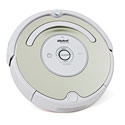Difference between revisions of "Roomba project"
| Line 8: | Line 8: | ||
|resarea=Robotics | |resarea=Robotics | ||
|restopic=Robot development; | |restopic=Robot development; | ||
| − | |start=2010/05/ | + | |start=2010/05/10 |
|end=2010/09/25 | |end=2010/09/25 | ||
|status=Active | |status=Active | ||
Revision as of 17:59, 28 July 2010
Roomba Analysis and Modification
| |
| Short Description: | Roomba's control system study and modification |
| Coordinator: | GiuseppinaGini (gini@elet.polimi.it) |
| Tutor: | ThomasFerrari (tferrari@elet.polimi.it) |
| Collaborator: | |
| Students: | AndreaScalise (andrea.scalise@aol.it), NiccoloTenti (nicotenti@libero.it) |
| Research Area: | Robotics |
| Research Topic: | Robot development |
| Start: | 2010/05/10 |
| End: | 2010/09/25 |
| Status: | Active |
| Level: | Ms |
| Type: | Course |
This project is about studying the vacuum cleaner Roomba's brain, in order to modify and add new behaviours to it: in particular a wall-following algorithm will be implemented and tested. The interfacing with the robot will be provided by Pyro, a library, environment, graphical user interface to explore AI and robotics using the Python language.
Interfacing with Pyro
Pyro is a powerful software written in Python, used to provide a high level interface to many types of robots, regardless of their hardware structure. Here the main steps to configure properly the Pyro environment and to interface it with a Roomba.
Download and install Pyro
First of all, you need to download the latest version of Pyro. You can choose between different versions and operative systems from this website: PyroDownload. Since the project will be developed under Linux, we will refer to Linux Ubuntu OS, using the Pyro version 5.0.0. Then, you need to install it, in the usual way from terminal, with the commands:
./configure.py make makefile
To run the program, copy the pyrobot executable file (pyrobot.py) in your home folder, and from terminal write:
./pyrobot.py
